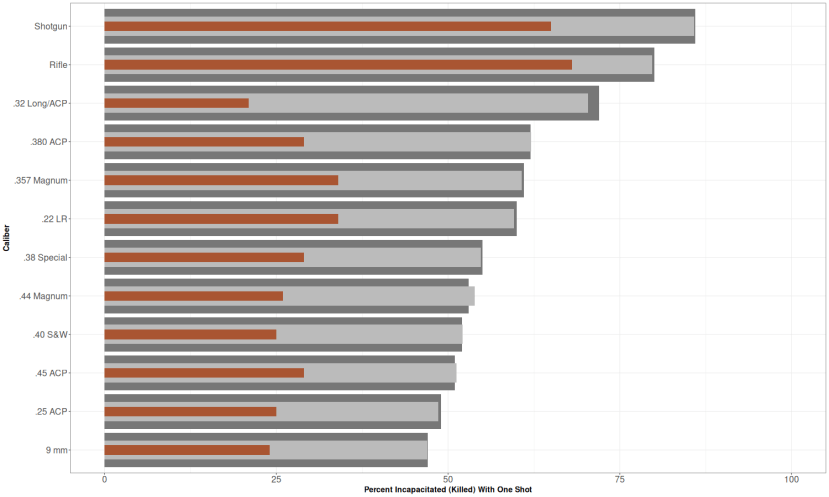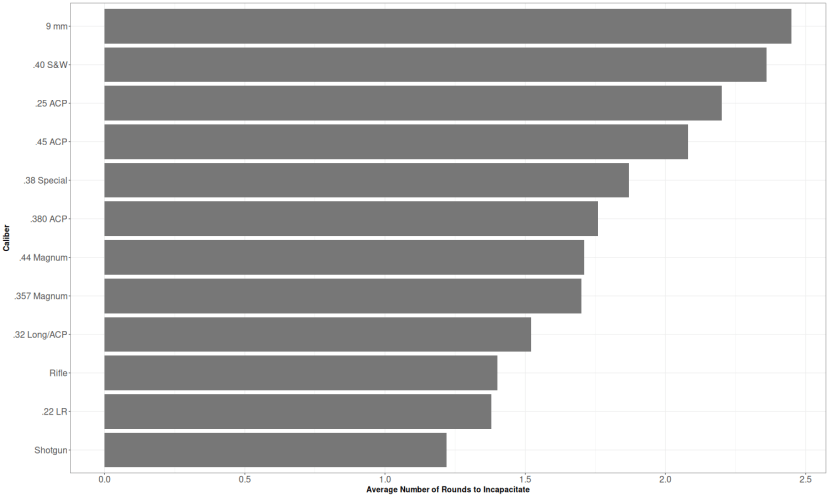It is a slow week, and a week of Thanks, so let’s spend our time with some fun things.
Like a fascinating study by Greg Ellifritz on “An Alternate Look at Handgun Stopping Power“. (There are more than just his: this post is mainly for fun.)
“Stopping power” is a somewhat vague term, which doesn’t stop ceaseless claims of this or that round having superior “stopping power.” What makes Ellifritz’s examination worthy is that he quantifies its definition across several dimensions.
Except for one. Which is entirely caliber independent. I mean those times when a mere gun reveal is sufficient to discourage your enemy and he leaves off. I’ve seen varying statistics on this, but it’s not a small number. And to an extent unknown, of course, because most of these confrontations would never be reported, and so no data is ever collected on them.
Which only means, for us, that Ellifritz’s study is conditional on those times in which a firearm was fired. His numbers are therefore a global underestimate of overall stopping power. According to Ellifritz:
Over a 10-year period, I kept track of stopping power results from every shooting I could find. I talked to the participants of gunfights, read police reports, attended autopsies, and scoured the newspapers, magazines, and Internet for any reliable accounts of what happened to the human body when it was shot…
Every shot in this study took place during a military battle or an altercation with a criminal.
He cataloged number of people shot at, number of shots, number of hits, number of fatalities, accuracy, and, my favorite, one-shot-stop percentage, which means just what it says. He had about 1,800 incidents.
Now this data has been played with in many places, and I won’t be able to milk much more out of than others already have. Except to point out the strengths and weaknesses of any kind of statistical modeling. I mean models applied to any kind of data. I want you to distrust statistical modeling.
For if you know a lot about shooting, you’ll easily see the flaws and loose generalizations in these models. But you might not see these flaws when you see “news” reports like “Research shows eating non-manufactured food is bad for you”. You figure the Experts who produce these things must have got it right, because it’s their job. Never be that hasty.
Like I said, here’s my favorite definition of “stopping power”: “% actually incapacitated by one shot (torso or head hit)”. If you take one shot and hit your opponent in the torso or head and he leaves off, well, I count that as a win.
The dark grey are the observed rates. Because the sample sizes varied so much between calibers, some calibers seeing a lot fewer shots, I used a very simple predictive model (based on Laplace’s law of succession) to smooth out the variation. That’s the light grey. Not that different.
The red insets are fatality percentages. The 22 LR are all handguns; and the Rifle are any centerfire. It was all kinds of shotguns, but 90% were 12 gauge.
This is our statistical model. The model includes the data that goes into it, and all the circumstances of that data, and a lot of other implicit premises we’ll come to. (Yes! The data is the model, too.)
So, if your definition of “stopping power” is incapacitation after one shot, then, according to this model, you should use a shotgun and never use a 9 mm.
Yet in Reality, the 9 mm is the most popular cartridge. And you never see—not yet, anyway—people strolling down the street wearing an Ash boomstick back holster. (I want one of these.)
There’s an implicit premise right there: circumstance. You are not, or not usually, out and about with a shotgun (more’s the pity; and I unknowingly originally wrote shotfun), but many wander around with 9 mms. Ellifritz also mentions another circumstance: a lot of that 9 mm data is “ball” or full metal jacket ammo, which is no longer carried that much, giving out in favor of some kind of hollow point (or the like). And anyway, a 9 mm round of any kind is never going to beat a shell loaded with buckshot or a slug, given equal shot skill and placement.
Now this is not the only definition of “stopping power”, and because it includes a hit to head or torso, it is too specific. Because many people miss. Even I myself have had targets change location after I pressed the trigger.
So a second definition is number of shots until incapacitation, where a shot is not always a hit.
Same color scheme, where here it is the average number of rounds until incapacitation. (I’ve ignored the formal model here, since we only have reported means.)
What’s this? A .22 LR better than a 9 mm? Again, this is conditional on the model, with all its implicit premises. One is accuracy: .22s were 62% accurate at hitting the head or torso, and 9 mm 74%. Which doesn’t make any sense. Unless it’s because—and here are more circumstances—that 9 mm FMJ ammo is just passing right through and causing less pain than the .22s, which (according to the many tests I’ve seen) would tend to stay insides bodies. Ouch. So you need shoot less. Could be.
Anyway, the shotfun comes out on top (on the bottom) again.
Perhaps the shotgun has better no-shot stopping power, too, particularly the pump-action shotgun. You can always shout “I have a gun” with any hand gun. But that sound, that very peculiar satisfying sound, a shotgun makes as you cycle a round into the chamber. Well. That can be mighty discouraging to an opponent.
All models only become valuable when they are used to make decisions, and those decisions turn out to be good ones.
I have a Mossberg 590S Shockwave by the bedside, with 2 buckshot minis, followed by 4 slug minis, and topped off by 2 more buckshot minis. I like the symmetry.
By the bedside? Yes. Late, very late at night, it sings to me.
What’s your decision?
Subscribe or donate to support this site and its wholly independent host using credit card click here. Or use the paid subscription at Substack. Cash App: $WilliamMBriggs. For Zelle, use my email: matt@wmbriggs.com, and please include yours so I know who to thank.






Well, my father always said a handgun is only useful to give you time to get to your shotgun, so you cut out the middle man, well done!
As you said, circumstance matters. The location of the shooting is going to determine what weapon you have on hand. That's where the pistol shines as an everyday carry. The shotgun incidents likely all happened in the home, whereas pistol incidents could happen anywhere. This could be related to your deterrence statement, but you're more likely to get yourself arrested walking around with a long gun than with a holstered pistol.